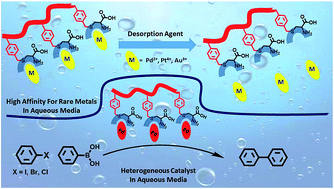Preparation of a zwitterionic polymer based on l-cysteine for recovery application of precious metals†
Abstract
L-Cysteine-grafted polystyrene (Poly(Cys-g-Sty)), was synthesized from a cysteine-styrene monomer (Cys-Sty) in aqueous solution and used as a facile and selective high-recovery material for palladium(II), platinum(IV), and gold(III) ions from aqueous media. The high solubility of the polymer in aqueous metal ion solutions allows for homogeneous and effective adsorption on the polymer in under 1 min. The maximum recovery amounts were found to be 0.442 g g−1 (4.153 mmol g−1), 0.701 g g−1 (3.593 mmol g−1), and as 1.345 g g−1 (6.829 mmol g−1) for palladium(II), platinum(IV), and gold(III), respectively. In the case of platinum and gold, the maximum recovery amounts were greater than for other recovery materials reported in the literature. The obtained Poly(Cys-g-Sty) showed a higher affinity for these three precious metals, even in the presence of other metal ions. The desorption application was performed using various reagents. The solution of 0.5 M NaOH and 1 M KCN provides the maximum desorption efficiency of precious metal ions from the polymer. As one of the applications, the palladium and polymer complex (Poly(Cys-g-Sty)–Pd) was also used as a heterogeneous catalyst for the Suzuki–Miyaura coupling reaction with a high efficiency.



 Please wait while we load your content...
Please wait while we load your content...